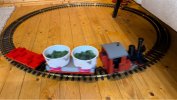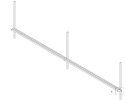Microgreens
Registered
HI!
I want to build a railway inside my greenhouse to transport our flowers to the warehouse for packing. I have bought a building block starter set to test and it worked perfectly!
The system will be U shapped, with a total of 120 meters, with a single track, no turnouts. The central station 3 will control the train and automations
Along the track I plan to install contact point that are activated via magnet on the train so I can know where the train is and also so I can send it to specific points on the track.
My question is, how should I feed this track? Is 1 cable (1 injection point) enough for a track this size? Or should I use multiple points along the track? If so, how is this wiring done?
I bought a S88 link to connect to the contacts on the track, can I have is near the central station and run cables along the length of the track to connect to the contacts? Or is 120 meters too much for these feedback contacts to work?
I have watched countless hours of videos on youtube, read instruction manuals and search the web for these answers, but wasn't able to find anything usefull. Is someone can help me I would be very greatfull!
Thanks,
Tomás
I want to build a railway inside my greenhouse to transport our flowers to the warehouse for packing. I have bought a building block starter set to test and it worked perfectly!
The system will be U shapped, with a total of 120 meters, with a single track, no turnouts. The central station 3 will control the train and automations
Along the track I plan to install contact point that are activated via magnet on the train so I can know where the train is and also so I can send it to specific points on the track.
My question is, how should I feed this track? Is 1 cable (1 injection point) enough for a track this size? Or should I use multiple points along the track? If so, how is this wiring done?
I bought a S88 link to connect to the contacts on the track, can I have is near the central station and run cables along the length of the track to connect to the contacts? Or is 120 meters too much for these feedback contacts to work?
I have watched countless hours of videos on youtube, read instruction manuals and search the web for these answers, but wasn't able to find anything usefull. Is someone can help me I would be very greatfull!
Thanks,
Tomás






